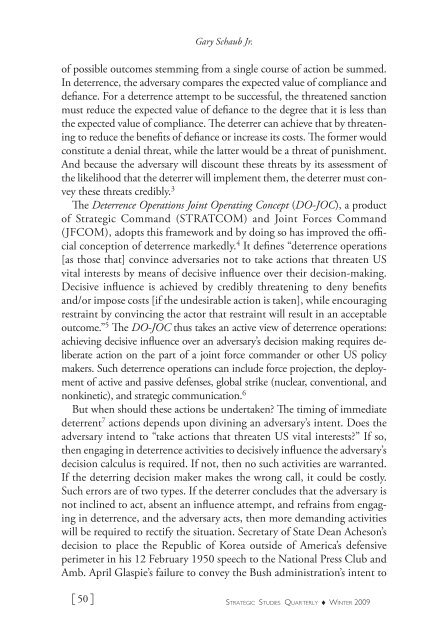When Is Deterrence Necessary? Gauging Adversary Intent
When Is Deterrence Necessary? Gauging Adversary Intent
When Is Deterrence Necessary? Gauging Adversary Intent
You also want an ePaper? Increase the reach of your titles
YUMPU automatically turns print PDFs into web optimized ePapers that Google loves.
Gary Schaub Jr.<br />
of possible outcomes stemming from a single course of action be summed.<br />
In deterrence, the adversary compares the expected value of compliance and<br />
defiance. For a deterrence attempt to be successful, the threatened sanction<br />
must reduce the expected value of defiance to the degree that it is less than<br />
the expected value of compliance. The deterrer can achieve that by threatening<br />
to reduce the benefits of defiance or increase its costs. The former would<br />
constitute a denial threat, while the latter would be a threat of punishment.<br />
And because the adversary will discount these threats by its assessment of<br />
the likelihood that the deterrer will implement them, the deterrer must convey<br />
these threats credibly. 3<br />
The <strong>Deterrence</strong> Operations Joint Operating Concept (DO-JOC), a product<br />
of Strategic Command (STRATCOM) and Joint Forces Command<br />
(JFCOM), adopts this framework and by doing so has improved the offcial<br />
conception of deterrence markedly. 4 It defines “deterrence operations<br />
[as those that] convince adversaries not to take actions that threaten US<br />
vital interests by means of decisive influence over their decision-making.<br />
Decisive influence is achieved by credibly threatening to deny benefits<br />
and/or impose costs [if the undesirable action is taken], while encouraging<br />
restraint by convincing the actor that restraint will result in an acceptable<br />
outcome.” 5 The DO-JOC thus takes an active view of deterrence operations:<br />
achieving decisive influence over an adversary’s decision making requires deliberate<br />
action on the part of a joint force commander or other US policy<br />
makers. Such deterrence operations can include force projection, the deployment<br />
of active and passive defenses, global strike (nuclear, conventional, and<br />
nonkinetic), and strategic communication. 6<br />
But when should these actions be undertaken? The timing of immediate<br />
deterrent 7 actions depends upon divining an adversary’s intent. Does the<br />
adversary intend to “take actions that threaten US vital interests?” If so,<br />
then engaging in deterrence activities to decisively influence the adversary’s<br />
decision calculus is required. If not, then no such activities are warranted.<br />
If the deterring decision maker makes the wrong call, it could be costly.<br />
Such errors are of two types. If the deterrer concludes that the adversary is<br />
not inclined to act, absent an influence attempt, and refrains from engaging<br />
in deterrence, and the adversary acts, then more demanding activities<br />
will be required to rectify the situation. Secretary of State Dean Acheson’s<br />
decision to place the Republic of Korea outside of America’s defensive<br />
perimeter in his 12 February 1950 speech to the National Press Club and<br />
Amb. April Glaspie’s failure to convey the Bush administration’s intent to<br />
[ 50 ]<br />
Strategic Studies Quarterly ♦ Winter 2009
















